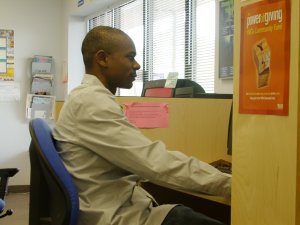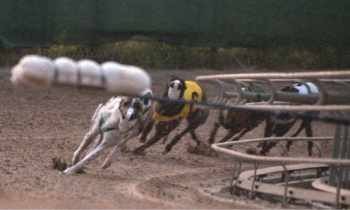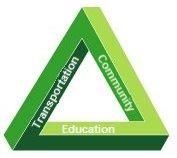The Trojan Triangle
At the beginning of the documentation of the Trojan Triangle, after the intro to the subject, I began with a brief profile of Michael Porter, Harvard Guru. Porter proselytizes all over the world from his Holy Book of "Competition, Strategy and Innovation" targeted at national and regional economic areas. What Herr Porter is really teaching is 'Slice and Dice Economics for Social Capitalism'. Social capitalism isn't really capitalism of course. One could call it cooperative capitalism but that's just more obfuscation. What it really is - is the strategy for economic transformation to socialism.

Slice and Dice Economics
Before I begin doing some slicing and dicing of my own, we need to step back in time and take a look at the impact of automation in general with automation being defined as computer systems, software and communications networks because Michael Porter's work is just a logical progression economic and social engineering dating back to the 1940's (and before that even) and Wassily Leontief. Leontief was a Russian born, Russian trained economist who ended up teaching and researching at Harvard University. In 1953, Leontief published an article revealing research results that came to be known as the Leontief Paradox. (Note: input-output analysis is the analysis of production inputs and outputs - more commonly known as supply chain today):
Leontief's Paradox
Early on, input-output analysis was used to estimate the economy-wide impact of converting from war production to civilian production after World War II. It has also been used to understand the flow of trade between countries.
Indeed, a 1953 article by Wassily Leontief showed, using input-output analysis, that United States exports were relatively labor-intensive compared to United States imports. This was the opposite of what economists had expected at the time, given the high level of U.S. wages and the relatively high amount of capital per worker in the United States. Leontief's finding was termed the Leontief paradox.
Since then, the paradox has been resolved. It has been argued that the US has an advantage in highly skilled labor more so than capital. This can be seen as viewing "capital" more broadly, to include human capital. Using this definition, the exports of the U.S. are very (human) capital-intensive, and not particularly intensive in (unskilled) labor.
Economists try to explain everything within
the box of business as you can see from the resolution given for the
paradox. That resolution was dead wrong but we are still living
with it today. Obviously, the higher wages were due first to the
requirements for labor during war time and secondly because in a
technologically advancing country, each business needs more money to
implement the latest advancements which causes rising prices across the
board, the infrastructure to support an advancing economy costs
more, so you have higher taxes plus the fractional reserve banking
system that is always stealing value from the dollar makes costs
increase incrementally over time. And all of that requires that wages
increase to keep pace. But, that aside, the effect of the
Leontief Paradox was to cause manufacturers who were the biggest
employers of the time, to start looking to export some of the
labor-intensive production to cheaper wage countries. What the
manufacturers gained from that was efficiency of capital - more
production for less money.
At about the
same time, computers were reaching the stage of development that they
could be used for business purposes which opened up a new sector of
employment in the economy to support automation of administrative
functions. This allowed us to lose employment in the manufacturing
sector with replacement jobs being created in business automation.
Some people did become permanently, structurally unemployed but it was a
relatively small number compared to the opportunities created in the new
sector.


The net effect of business automation was to decrease the number of people needed to manage larger and larger corporations. When the Internet became a public conveyance for information and data, allowing the export of office and business automation jobs to cheap labor countries, it created a labor market situation in which a huge percentage of people are - or will become permanently, structurally unemployed because businesses gain the efficiency of their capital by exporting the high dollar jobs to cheap wage countries.
In Search of a New Economic Miracle
The business efficiencies gained through automation and export of cost centers to cheaper locations have caused social costs to increase as the opportunities for employment have decreased. The solution given to us by the government (Harvard) economists is to mandate that there will be a new economic miracle. The new economic miracle commonly referred to as the 'Green Economy' is actually automation of the infrastructure - adding more efficiency reducing costs of operation. The problem with that of course is that the factors that led to our current economic problems are still in play (offshore production and administration) and anything to do with infrastructure is an overhead cost to the public, businesses and citizens. Put simply, the public must fund the development and implementation of the "Green Economy" and even if they succeed in developing new technologies, the offshore factors will still apply.
The important point here is to note that "The Green Economy" requires public funding which in political terms means government direction and ownership even if they hide it behind the facade of government funded small businesses in specially designated zones to give the appearance of private enterprise. This is the road to socialism and we are moving full speed ahead on it. As the number of real jobs decrease. The number of social jobs increase.
Slice and Dice Economics
With the above as background, we can now continue with Michael Porter and his proselytizing on "Competition, Strategy, and Innovation" as economic salvation for local communities. In 1980, Porter wrote a book titled, "Competitive Strategy". Keeping in mind that this game is progressive and each move is like a shovel full of dirt - digging the hole the deeper, the essence of "Competitive Strategy" is "don't compete with your competitors" - it will just hurt you both. Instead, become more cooperative and find ways for you both to be in business serving a unique niche segment in the market. The way that corporations found to do that was with operational agreements like Seattle Times and Post-Intelligencer (as I recall) agreement to share administrative operating costs while leaving the facade of two independent newspapers. The same happened with appliance manufacturers and their agreements to have one factory produce several brands of washing machines - with just a different brand name put on the machine.
The essential concept is to keep slicing off business processes as they become more expensive relative to the other costs of the remaining business until there is virtually nothing left except a zombie company that has been gutted from the inside out. It actually has a name. Co-opetition:
Co-opetition
-- this is the practice where companies work together for selected parts of their business where they do not believe they have competitive advantage, and consequently agree to collaborate in areas where they can share common costs. Consider for example, the collaboration between Toyota and Peugeot Citroen who share design, component parts and a jointly owned manufacturing plant to produce competing city cars. - Source: Wayne Mackintosh
President's Commission on Industrial
Competitiveness
June 28, 1983, President Ronald Reagan signed Executive Order 12428 creating the Commission on Industrial Competitiveness and he appointed John A. Young of Hewlett-Packard to be the Chairman. Michael Porter was appointed by Reagan to be a member of this commission.
The Commission produced a two volume report titled, "Global Competition: The New Reality". The executive summary written by Young contained the following definition:
"Competitiveness can be defined as the degree to which a nation can, under free and fair market conditions, produce goods and services that meet the test of international markets while at the same time maintaining or expanding the real incomes of its citizens."
Hmmm. Now let me think. In a "free and open" global market with 1.5 billion COMMUNIST Chinese workers and about 1.2 billion Indian workers... can our goods and services "meet the test"? Tic. Toc. Tic. Toc. I'm thinking...

What was the real test? It was: "Are we stupid enough to allow people like John A. Young and Michael Porter to put us in an economic contest with India and China - especially after we give them the technology to "compete" with us like we did with Japan? Apparently the members of the American Congress were that stupid because that's exactly what they did. And we're losing. And it was a 'No Brainer' that we would lose because "Services" are jobs and people. We lost the "contest" before it ever began because it was a con man's trick to get us into a rigged game.
"if you don't have a competitive advantage, don't compete." Jack Welsh, former CEO of GE
From an article titled, "Mr.
Young Goes to Washington"
by Max Holland:
"One of the first things Young did was seek the counsel of David Gardner, president of the University of California system. Gardner had just finished heading the commission that produced "A Nation at Risk," an acclaimed study that bolstered public attention on the decline in public schools. The effort was all the more impressive since the White House’s support had been tepid at best. From Gardner, Young learned a lot about commission dynamics: what to expect, what to avoid, how to get the right

John A. Young, Fascist,
Former CEO of HP
mix of views and personalities, and how to handle dissenting views. Young realized that the PCIC, as proposed, was deeply flawed. Its mechanics were too dependent on the White House and its membership overly weighted toward a congenial point of view. Organized labor wasn’t even represented on the commission.
Young recruited the labor representatives himself, and also persuaded the former head of Morgan Stanley Group and some high-technology CEOs to join up. Simultaneously, he lobbied the administration to give the PCIC its own staff and budget rather than run it out of the White House. By the time it sat down to work, the PCIC had achieved a good deal of independence.
...Young sounded out some of his fellow commission members and they agreed to organize a new combatant in Washington’s war of ideas, a private duplicate of the PCIC. They borrowed a non-profit shell that NAM had established with the Internal Revenue Service, and Trowbridge kicked in $75,000 to get things started. Young began recruiting CEOs from corporations, universities, and unions to join, and within weeks he won the allegiance of prominent business, academic, and labor leaders. The Council on Competitiveness opened for business in August 1986.
In the Remarks of Senator John Heinz, member of the President's Commission on Industrial Competitiveness, Pittsburgh, Pennsylvania on February 2, 1984, excerpts:
"A government industrial commission to study sectoral problems and pick industries of the future -- that is, select winners and losers -- is central planning. So is a redevelopment bank that would take credit allocation out of the hands of the market and put it into the hands of politicians. Let's face it: we may be great fellows individually, but we are not an entirely objective and disinterested lot!
And indeed they weren't. John Young's objectives were Hewlett-Packard's bottom line. Following the establishment of Council on Competitiveness - a group of traitors to America if ever there were any, John Young then established the Computer Systems Policy Project. The policies of this group parallel the "redesign" of our government - which transformed the government into a fascist corporate state coupled with the communist system of soviets for manipulation of local governments to facilitate the policies.
Young was a founding director and trustee of the Foundation for the Malcolm Baldrige National Quality Award, and served as the president of the foundation during 1990. He was named co-chairman of the President's Committee of Advisors on Science and Technology in 1994. He is founding chairman of the Computer Systems Policy Project, an affiliation of chief executive officers of American computer systems companies who formulate and advocate public-policy recommendations of critical importance to the computer industry. He also served as a member of the Advisory Committee for Trade Policy and Negotiations with the Office of the United States Trade Representative and is a member of the Business Council and the National Academy of Engineering. He also was founding chairman of the board of Smart Valley, Inc., a nonprofit corporation formed in 1993 to create an electronic community in Silicon Valley.
Continue raging tangent thread HERE (not active yet)
Communities and Local Economies
With the collapse of the real economy, the transfer of ownership of local economies is being accomplished through the Trojan Triangles of the Universities, Zones and Systems of Control and the social currency funnel controlled by Communists with a specific agenda - to put people of the United States in a lock-down control grid. The Systems that brought convenience are now bringing a tyranny that the world has never seen before. Most people won't even see it coming - until it's too late. As with all my work, I'm trying to show not only what they are doing but how they are doing it. To stop them, you must recognize the systems of control and stop the implementation of them.
Porter's Clusters
"Clusters are geographic concentrations of interconnected companies, specialized suppliers, service providers, and associated institutions in a particular field that are present in a nation or region. Clusters arise because they increase the productivity with which companies can compete. The development and upgrading of clusters is an important agenda for governments, companies, and other institutions. Cluster development initiatives are an important new direction in economic policy, building on earlier efforts in macroeconomic stabilization, privatization, market opening, and reducing the costs of doing business." Michael E. Porter, Institute for Strategy and Competitiveness
What Porter is describing is the identification of supply chains in the local communities for the ultimate purpose of controlling them. Porter's entire schtick at this point is the facilitation and training for the local community leaders in the methodology to study the local business community and to produce the documentation necessary to implement the Education piece of the control grid.
If you recall in the section of this paper titled, "Education", a project called "SCANS" was initiated by the U.S. Labor Department. The stated purpose of the SCANS project was to define "What Work Requires of Schools". To do that, they needed to catalog the types of jobs and the requirements for the jobs. Johns-Hopkins got the job - and note the name of the person who led the project.... Arnold Packer.. same guy who wrote the Workforce 2000 report for the U.S. Labor Department (William Brock). (It's so difficult for me not to go into a Tourette's mimicking ranting rage as I write this. This whole system of "education reform" beginning with the 'Nation at Risk' report through the redesign of the schools to soviet polytechnical education was propaganda for the purpose of spending on computer systems.
A paper called, "SCANS Process" (with Packer's name on it) describes the project including reference to the modification of curriculum to integrate "workplace skills" and provide a system of "certifications" for a lifelong system of tracking work history and training. The Clusters are the result of the analysis of businesses in a community. The business cluster information serves as the input for the school curriculum which is tailored for the clusters and includes free labor "internships" which are part of the "certification" process for the job. This is a local business community scam of "school-to-work" - a closed loop system of perpetual training and dead-end life opportunities. That's the above ground purpose that is admitted and written about.
But that's not the only purpose of Porter's "system". The other purpose has to do with power and influence in the community. In a village full of starving people, the man with bread is king. The "innovation" part of Porter's system is the University selection of the Kings. The University is linked to a Zone of Control where the selected Kings are provided funding and assistance to start businesses in an alleged system of "Transfer of Technology" - from research to commercialization. Of course most of the "research" from the universities isn't really research. It's just taxpayer money funneled to the Universities under the heading of research to provide the funding for the 'Transfer of Control'.
Just recently, another piece of the puzzle was revealed in a News article in the Idaho Statesman. The EB-5 visa. The EB-5 visa is a "foreign investor" visa - that for the price of a million dollars or half a million, foreigners can buy entry to the country - and can establish a business in the Zone of Control. The Zones of Control come with tax abatement benefits and tax credits for costs associated with the creation of jobs - coupled with the benefits of "free labor" provided by the students in the school-to-work system.
The "competition" part of this comes when the businesses in the Zones of Control "compete" with businesses outside the zones. The unequal playing field gives the Zone Businesses enough of an advantage to put the local business owners at a competitive disadvantage - and they lose. This is the method of the transfer of control of the community to foreign owners. And how do I know that? Because if you listen to business News, they always report that the vast majority of new, small businesses are started by immigrants. And now you know why. And it should be pointed out, that the same thing is being done on other countries. The foreign ownership is a means of destabilization of local populations - making this really, in point of fact, a military strategy for domination that is cloaked in civilian terms.
The above paragraphs are a compact description of what is really a highly sophisticated, strategic plan for takeover of the economy - implementing a fully, centrally planned socialist system of control. There are volumes of documentation written about each aspect of it - but you have to cut through the cr*p to get to the essence and then put it together like pieces of a puzzle. Below, you will find links to articles and reports to support everything I've told you above.
"The CORE" in Meridian, Idaho is a Trojan Triangle. The final segment of this documentation on Trojan Triangles will be to look at one as it is being established.
Vicky Davis
July, 1, 2010
Note: The documentation sampling below is only a fraction of what I have - or could find. If I left any gaps in the strategy such that you don't see the connections, let me know and I'll find it for you.
Regional Competitiveness, Innovation and Entrepreneurship by Brian
Dabson
Blueprint for American Prosperity, "Clusters and Competitiveness: A
New Federal Role for Regional Economies, Brookings Institute
(search on 'Michael Porter' - many references)
Measuring Regional Innovation, U.S. Dept of Commerce, Economic
Development Administration
"Clusters of Innovation Initiative: Regional Foundations of U.S.
Competitiveness"
Article
Report
Governor's Guide to Cluster Based Economic Development, National
Governor's Association
Technet
Innovation Initiative
"An
Analysis of Transfer Mechanisms for Federally Funded Research and
Development", James J. Winebrake, MIT
Innovation and Commercialization of emerging technologies, U.S.
Office of Technology Assessment
Weddle -
Triangle Innovation
Best Practices in the Implementation of Cluster-Focused Strategy
Economic
Development - The Missing Link
Hispanic Serving Institutions - STEM
1984 - Technology,
Innovation, Economic Development; U.S. Office of Technology
Assessment
1987 - Education and
Economic Development - Haynes, Chloe J., ERIC
Education -
Industry Clusters
Co-opetition
Co-opetition: a source of international opportunities in Finnish
SME's
The Value
Net Game
Knowledge Transfer and Small Business - University of Warwick, UK
Benchmarking the North American Strategies in Cluster Development
Ohio
Wired -
Workforce Innovation in Regional Economic Development
Third Frontier Internship Program
Third Frontier Marketing Brochure
Insourcing Jobs
Wisconsin
Economic Development Summit
Texas
Competitiveness and Texas, Michael Porter
Illinois
Chicago Clusters
Technical Report
Oregon
Business Summit -
Clusters
European Union
Developing Cluster Policies in Seven European Regions
Promoting Innovative Intermodal Freight Transport - Clustering
Germany
Economic
Policy and Clusters
Croatia
Tourism
Clusters
Basque
Clusters and Competitiveness
Thailand
Competitiveness Initiative - U.S. Government Funded Program, USAID
Spain
"The
Foundation" - Clusters
Rural Areas
Unlocking Rural Competitiveness - The Role of Regional Clusters

